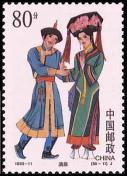The traditional costumes of a Manchu man are a narrow-cuffed short jacket over a long gown with a belt at the waist to facilitate horse-riding and hunting. Manchu women used to wear loose-bodied Cheongsams and embroidered shoes or pattens. In past times, Manchu men wore their hair long. They braided their hair and let the braids droop behind their heads. Women coiled their hair on top of their heads and wore earrings and headgear. Manchu women didn’t need to suffer from footbinding. Manchus is striped-pants in formality. In the past days, the junior would send their formal regards to the eldership | 
|
every day. In greeting their superiors, men were required to extend their left hand to the knee and idle the right hand while scraping a bow, and women would squat with both hands on the knees. Embracing the waist and touching faces were regarded as the necessary behaviors when relatives or friends met. Kowtow is one of the formal salutes of Manchu. On the occasions of a wedding ceremony, funeral or facing emperor or officials, kowtow would be sent. Manchu and Han basically share the same festivals and holidays, although there are still some differences in respect to celebrating ceremonies. The Manchus like to eat millet. Their festivals were traditionally celebrated with dumplings, and, on New Year’s Eve, with a treat of stewed meat. Boiled and roast pork and Manchu-style cookies were table delicacies. As a kind of royal food, the Manchu snack “Saqima”, a kind of candied fritter has been welcomed by other nationalities. Regarding taboos, killing and eating dog meat is forbidden to Manchus. |